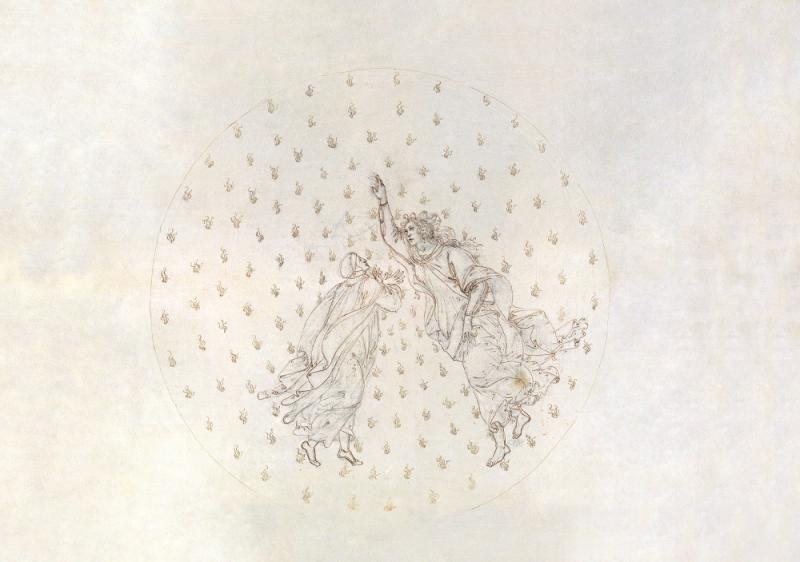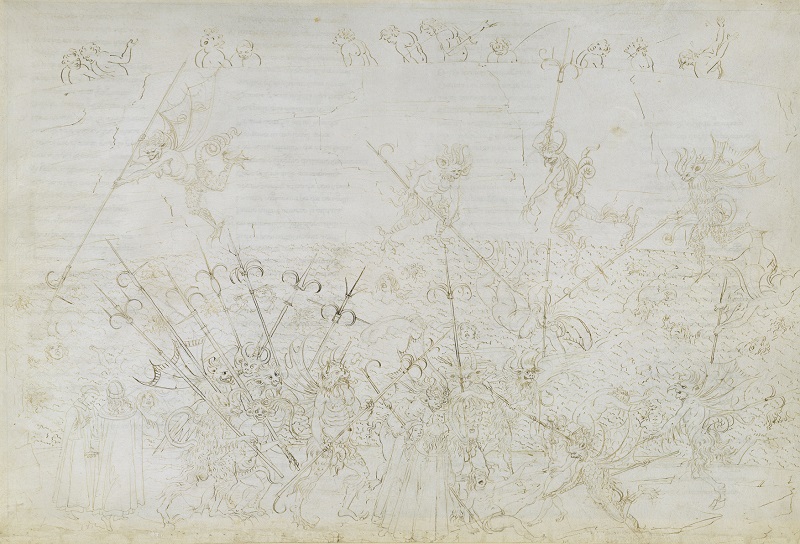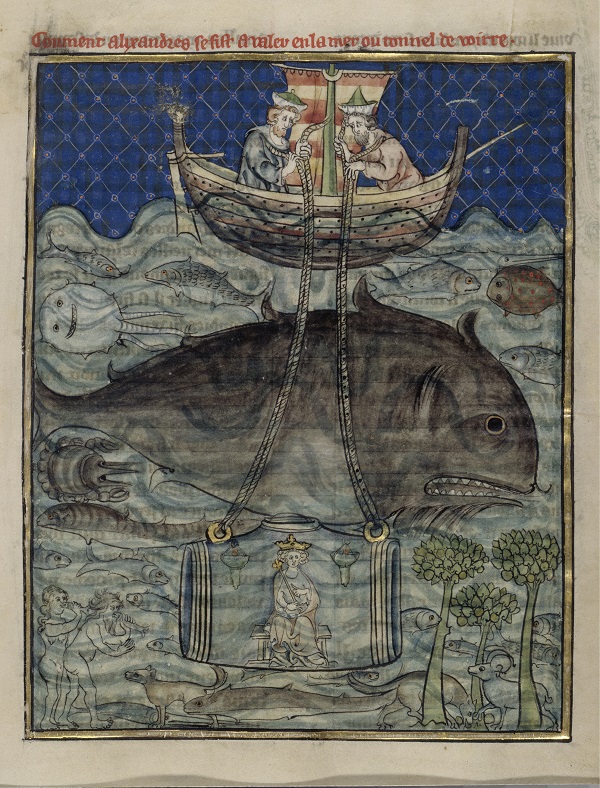Botticelli and Treasures from the Hamilton Collection, Courtauld Gallery | reviews, news & interviews
Botticelli and Treasures from the Hamilton Collection, Courtauld Gallery
Botticelli and Treasures from the Hamilton Collection, Courtauld Gallery
The drawings for Dante's 'Divine Comedy': a swansong for the age of manuscript illumination

In Hell, the souls of the damned endure cruelly imaginative punishments for all eternity. Corrupt churchmen are buried headfirst in the ground with their feet set on fire, and soothsayers, who in life presumed to be able to see into the future, have their heads turned 180 degrees and are forced to walk around looking backwards. Drawn in metalpoint strengthened here and there with ink, Botticelli’s lines are as fine as spider’s silk.
Spanning a vast emotional, technical and narrative range, this selection of sheets from Botticelli’s most ambitious and enigmatic work, the illustrations for Dante’s Divine Comedy represent an absolute embodiment of Renaissance achievement. Vasari’s brief but evocative description of an artist obsessed with a project, “on which he [Botticelli] wasted much of his time, bringing infinite disorder into his life by neglecting his work” appeals to the Renaissance conception of the artist as an individual creative genius, and Botticelli seems to have laboured for some 15 years to bring the drawings to a state of not even near-completion.
For all their lack of completeness, the drawings serve as an exemplar of that strangely slippery term disegno. Popularised by Vasari, its meaning goes beyond draughtsmanship to encompass design, demonstrated here in the accomplished way that Botticelli wrestles Dante’s complex, epic poem into a coherent visual translation that remains remarkably faithful to its source.
 Throughout the series, Botticelli depicts the human figure in endlessly varied poses and emotional states, with certain sheets, like Inferno XXXIII in which the souls of the treacherous are frozen into myriad contorted poses, providing particularly rich opportunities for Botticelli to exploit. But this isn’t just about showing off: Botticelli’s ability to convey the expressive capabilities of the body give the drawings immense narrative power (pictured above: Punishment of the corrupt in the eighth circle, Divine Comedy, Inferno XXII, c.1481-1495).
Throughout the series, Botticelli depicts the human figure in endlessly varied poses and emotional states, with certain sheets, like Inferno XXXIII in which the souls of the treacherous are frozen into myriad contorted poses, providing particularly rich opportunities for Botticelli to exploit. But this isn’t just about showing off: Botticelli’s ability to convey the expressive capabilities of the body give the drawings immense narrative power (pictured above: Punishment of the corrupt in the eighth circle, Divine Comedy, Inferno XXII, c.1481-1495).
In one of the first sheets seen here, Inferno XVII, Dante clings to his guide, the Roman poet Virgil, as they descend into the abyss on the back of Geryon, a chimeric monster with a man’s head and a scorpion’s tail. At one point Dante’s face is almost completely obscured, but his hunched, shrinking shoulders are a compelling depiction of pure terror.
The encounters between Dante and his beloved Beatrice are perhaps the most complex in the series, and their conversations are made visually eloquent by the careful positioning of their bodies (main picture: Dante and Beatrice in the second planetary sphere of Paradise, Divine Comedy, Paradiso VI, c.1481-1495). In several places you can see how Botticelli adjusted position or gaze, and these pentimenti give some insight into how the expressive capacity of the body is used to convey complex narrative passages.
One of the more curious aspects of the drawings is Botticelli’s decision to use multiple representations of Dante and Virgil, in order to show narrative trajectory. It seems an archaic, almost medieval device and yet simultaneously it evokes modern techniques and genres like stop-motion animation, for instance, or the cartoon strip.
 The analogy of a cartoon strip gains force in the very few sheets that have been coloured. Sadly, none of these are on display here, and although most commentators including the late, great Kenneth Clark, thought it a blessing that most of the surviving 92 sheets remain as simple line drawings, those that have been coloured clearly show how the figures of Dante and Virgil might have served as route markers, plotting their progress through the chaotic topography of Hell and Purgatory.
The analogy of a cartoon strip gains force in the very few sheets that have been coloured. Sadly, none of these are on display here, and although most commentators including the late, great Kenneth Clark, thought it a blessing that most of the surviving 92 sheets remain as simple line drawings, those that have been coloured clearly show how the figures of Dante and Virgil might have served as route markers, plotting their progress through the chaotic topography of Hell and Purgatory.
The omission of the coloured sheets removes an intuitive link between Botticelli’s Divine Comedy and the illuminated manuscripts on display here, which provide a wider context for Botticelli's series beyond our admiration for them as virtuoso drawings. (Pictured above left: a page from The Romance of Alexander, c.1290-1300.)
Dating from the late 15th century, Botticelli’s Dante belongs firmly to the era of the printed book. Drawn on translucent vellum, the text on the back of each sheet shows through as a constant reminder that we are looking at, first and foremost, an extraordinarily ambitious and luxurious book, commissioned by Botticelli’s patron Lorenzo di Pierfrancesco de' Medici.
While the spread of the printing press made texts and books more widely available than ever before, the result was a boom period for the art of manuscript illumination. For Europe’s elite, unique, lavishly decorated books produced by scribe and artist became particularly sought after. In this context, the array of precious books from the Hamilton Collection, amassed during the early 19th century then sold off a couple of generations later to clear the gambling debts of the good-for-nothing 12th Duke of Hamilton, represents the last hurrah of an essentially medieval genre, one that would soon be swept away by new technology.
rating
Explore topics
Share this article
The future of Arts Journalism
You can stop theartsdesk.com closing!
We urgently need financing to survive. Our fundraising drive has thus far raised £49,000 but we need to reach £100,000 or we will be forced to close. Please contribute here: https://gofund.me/c3f6033d
And if you can forward this information to anyone who might assist, we’d be grateful.

Subscribe to theartsdesk.com
Thank you for continuing to read our work on theartsdesk.com. For unlimited access to every article in its entirety, including our archive of more than 15,000 pieces, we're asking for £5 per month or £40 per year. We feel it's a very good deal, and hope you do too.
To take a subscription now simply click here.
And if you're looking for that extra gift for a friend or family member, why not treat them to a theartsdesk.com gift subscription?
more Visual arts
 'We are bowled over!' Thank you for your messages of love and support
Much-appreciated words of commendation from readers and the cultural community
'We are bowled over!' Thank you for your messages of love and support
Much-appreciated words of commendation from readers and the cultural community
 Lee Miller, Tate Britain review - an extraordinary career that remains an enigma
Fashion photographer, artist or war reporter; will the real Lee Miller please step forward?
Lee Miller, Tate Britain review - an extraordinary career that remains an enigma
Fashion photographer, artist or war reporter; will the real Lee Miller please step forward?
 Kerry James Marshall: The Histories, Royal Academy review - a triumphant celebration of blackness
Room after room of glorious paintings
Kerry James Marshall: The Histories, Royal Academy review - a triumphant celebration of blackness
Room after room of glorious paintings
 Folkestone Triennial 2025 - landscape, seascape, art lovers' escape
Locally rooted festival brings home many but not all global concerns
Folkestone Triennial 2025 - landscape, seascape, art lovers' escape
Locally rooted festival brings home many but not all global concerns
 Sir Brian Clarke (1953-2025) - a personal tribute
Remembering an artist with a gift for the transcendent
Sir Brian Clarke (1953-2025) - a personal tribute
Remembering an artist with a gift for the transcendent
 Emily Kam Kngwarray, Tate Modern review - glimpses of another world
Pictures that are an affirmation of belonging
Emily Kam Kngwarray, Tate Modern review - glimpses of another world
Pictures that are an affirmation of belonging
 Kiefer / Van Gogh, Royal Academy review - a pairing of opposites
Small scale intensity meets large scale melodrama
Kiefer / Van Gogh, Royal Academy review - a pairing of opposites
Small scale intensity meets large scale melodrama
 Jenny Saville: The Anatomy of Painting, National Portrait Gallery review - a protégé losing her way
A brilliant painter in search of a worthwhile subject
Jenny Saville: The Anatomy of Painting, National Portrait Gallery review - a protégé losing her way
A brilliant painter in search of a worthwhile subject
 Abstract Erotic, Courtauld Gallery review - sculpture that is sensuous, funny and subversive
Testing the boundaries of good taste, and winning
Abstract Erotic, Courtauld Gallery review - sculpture that is sensuous, funny and subversive
Testing the boundaries of good taste, and winning
 Edward Burra, Tate Britain review - watercolour made mainstream
Social satire with a nasty bite
Edward Burra, Tate Britain review - watercolour made mainstream
Social satire with a nasty bite
 Ithell Colquhoun, Tate Britain review - revelations of a weird and wonderful world
Emanations from the unconscious
Ithell Colquhoun, Tate Britain review - revelations of a weird and wonderful world
Emanations from the unconscious
 Rachel Jones: Gated Canyons, Dulwich Picture Gallery review - teeth with a real bite
Mouths have never looked so good
Rachel Jones: Gated Canyons, Dulwich Picture Gallery review - teeth with a real bite
Mouths have never looked so good

Add comment